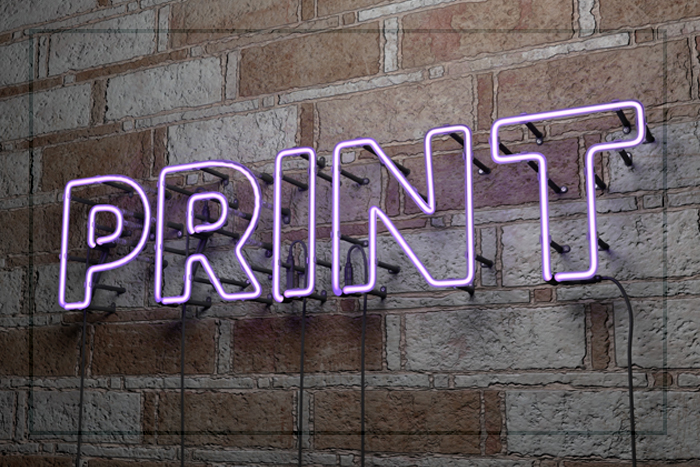05-30-2017
Does Print Still Have a Place in Healthcare Marketing?

Dear House Rules,
The future of healthcare marketing is digital – everyone knows that. So what about the few holdouts in our company’s marketing department who continue to advocate for print as part of an effective overall marketing mix? Are they stuck in the past – or are they actually on to something?
Signed,
Is little paper the secret weapon of Big Pharma?
Dear Secret Weapon: You got it in one. Yes, humble old paper is a key part of a successful healthcare marketing campaign, even though it’s 2017 and seemingly everyone has a smartphone and a computer both. There are plenty of hip young designers who may look down their noses at that dinosaur, the journal ad – and as for direct mail? You’re joking, right?
Think about it, though. Who are you trying to reach? In professional communications, it’s clinicians, many of whom are older. According to a census of actively licensed physicians in 2014, 54.5% were between the ages of 50 and 70+.(1) It’s likely that members of that age demographic are getting much of their medical information from professional journals in paper form, making journal ads as important as ever. In fact, an effective journal ad campaign can still become the cornerstone for a marketing strategy that then plays out across all media – including digital.
When it comes to reaching patients, many of the same demographic dynamics come into play, simply because of the nature of the major conditions being treated by pharmaceutical manufacturers. People who have type 2 diabetes, high cholesterol, or erectile dysfunction tend to be older as well.
There are several simple ways to make your print marketing even more relevant in this age of digital wizardry:
- Let your customers know how eco-friendly your print materials are: The paper industry is often?unfairly maligned?for being harmful to the environment, but paper can be recycled, and it’s also a renewable resource. In 2010, 63.5% of all paper consumed in the US was recycled, and the numbers have been increasing.(2)
Surprisingly, paper-based marketing also has a smaller carbon footprint than digital marketing, since carbon emissions are only produced once, during the creation of the product. Meanwhile, carbon emissions occur every time someone uses a digital device. Even the act of producing a CD creates more CO2 emissions than printing a 100-page report in full color.(2)
- Make sure your print and digital materials are designed separately: Your digital marketing and print marketing campaigns should promote the same message, but that doesn’t mean the designs are interchangeable. Many Web designs are not “print-ready,” and printing them without alteration will result in a misrepresentation of your brand.(2) For example, the colors you use for digital collateral may not print with accuracy. Designs made for the Web are created using a combination of red, green, and blue (RGB), whereas printed materials use cyan, magenta, yellow, and black (CMYK) to reproduce color. The differences can lead to discoloration and a color-matching disconnect between your branded design elements and your brand colors. You should also remain aware of the resolution of your images. Web designs tend to be lower resolution, with a standard of 72 dpi (dots per inch). Print materials, on the other hand, require higher-quality images set to at least 300 dpi.
- Be as creative in print as you are on the web: Many marketers make the mistake of forgoing creativity in their print materials in favor of sticking to the standard features; however, it’s hard to make an impact when your collateral doesn’t stand out. Remember, you’re not just restricted to a bland, printed rectangle; depending on the printer you choose (and, of course, your budget for the project,) millions of options may be available.2 For example, custom die-cutting lets you completely alter the shape of your media so you can do things like create business cards that are shaped like your product or add a uniquely shaped pocket to your presentation folder. Changing the shape of your media makes it easier to remember and harder to part with since it looks and feels different from the standard template.(2) In fact, the tactile feel of your marketing materials can help you create a stronger connection to your audience, because they’re experiencing your media using more than one sense at a time. That means picking a stock that feels sturdy (not flimsy) and possibly considering a textured stock like vellum, linen, or kraft for added impact. Special coatings such as soft touch or satin can give your media an extra textural component. (2)
At Xavier Creative House, we would love to partner with you to improve your print communications. Our expert team of art directors, copywriters, and print managers can make sure your next campaign works seamlessly with your other forms of communication. Let’s talk!
References: 1. https://www.fsmb.org/Media/Default/PDF/Census/2014census.pdf. Accessed May 21, 2017. 2. http://www.marketingprofs.com/articles/2013/11255/six-common-print-marketing-myths-debunked. Accessed May 21, 2017.?
Categories: healthcare marketing, pharma marketing,

